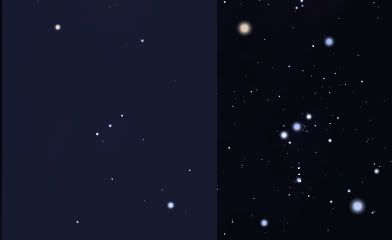The difference between these two simulated images of the constellation Orion is the amount of light pollution in the night sky. The view on the left is similar to what many city dwellers can see while the one on the right would come from a sky that is nearly free from light pollution.
Chances are you already know if your sky is free of light pollution or not (most likely not), but measuring and reporting the brightness of the sky where you live is a valuable and easy thing to do.
The Globe at Night program is your ticket to participate in a citizen-science campaign to measure the brightness of the night sky. This world-wide program, which uses the stars of Orion to help measure light pollution, runs from February 21 until March 6. Follow the link to Globe at Night for the details on how to participate. If you participate you'll be contributing to science and helping to measure light pollution, a growing problem throughout the world.
It is an unfortunate fact of city life that most of us have never truly experienced an awesome, dark sky. To see how beautiful the night sky can be have a look at this time-lapse movie of the Milky Way rising:
Here's a direct link to the video on YouTube.
To learn more about light pollution here is another video for you check out - Preserving Dark Skies, from McDonald Observatory.
Chances are you already know if your sky is free of light pollution or not (most likely not), but measuring and reporting the brightness of the sky where you live is a valuable and easy thing to do.
The Globe at Night program is your ticket to participate in a citizen-science campaign to measure the brightness of the night sky. This world-wide program, which uses the stars of Orion to help measure light pollution, runs from February 21 until March 6. Follow the link to Globe at Night for the details on how to participate. If you participate you'll be contributing to science and helping to measure light pollution, a growing problem throughout the world.
It is an unfortunate fact of city life that most of us have never truly experienced an awesome, dark sky. To see how beautiful the night sky can be have a look at this time-lapse movie of the Milky Way rising:
Here's a direct link to the video on YouTube.
To learn more about light pollution here is another video for you check out - Preserving Dark Skies, from McDonald Observatory.
By the way the two simulated views of Orion at the top of the page were produced using the desktop planetarium program known as Stellarium. I will eventually post a review here of Stellarium, but as you might imagine it is a worthy program available at a great price (It's free!).

No comments:
Post a Comment